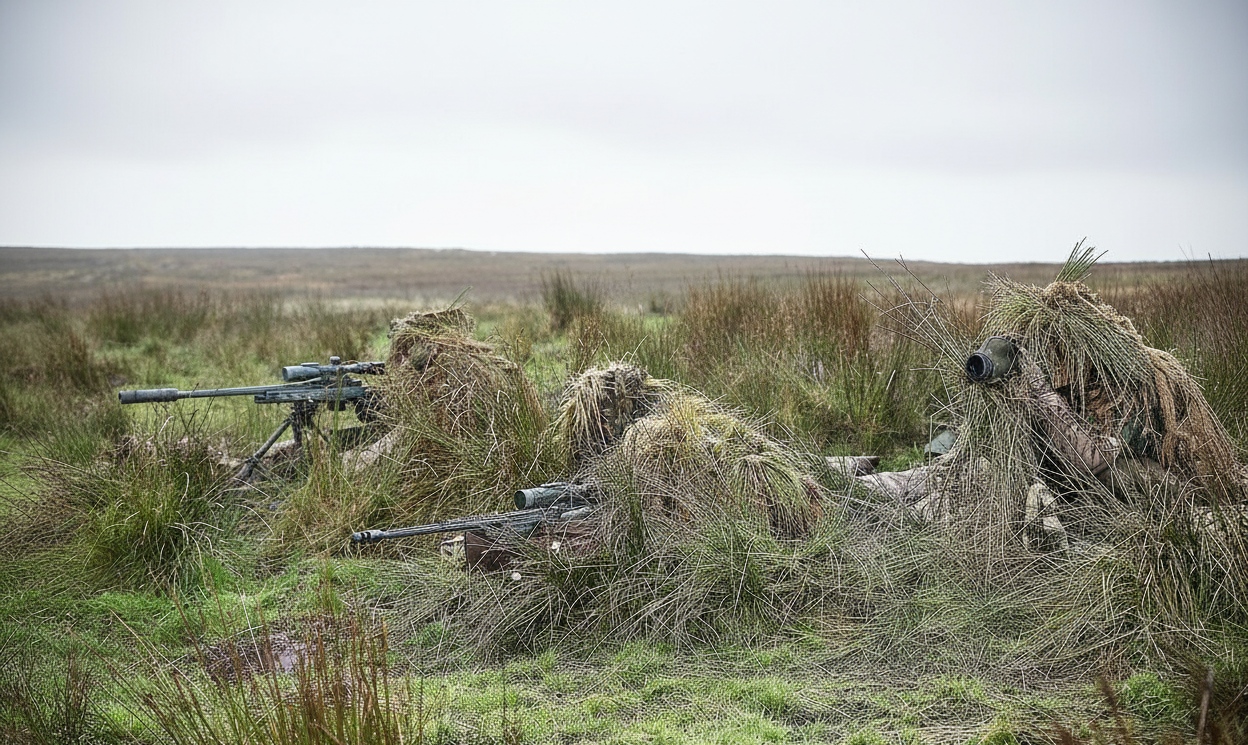What Is a Ghillie Suit?
A ghillie suit represents the pinnacle of individual camouflage. Designed to erase every trace of human presence in the environment, it turns its wearer into a natural extension of the terrain — whether that’s a damp forest, a rocky desert, or a snowy landscape.
Originally, used by military snipers and special forces, the ghillie suit has since become essential for anyone seeking total invisibility — from elite marksmen to professional hunters, wildlife photographers, and survival enthusiasts alike.
Today, this complete guide explores its evolution — from Scottish origins to modern applications — while specifically detailing the materials, construction techniques, technological innovations, and real-world uses.
In the end, it offers a deep dive into the art of disappearing in plain sight.
1. History and Origins | Ghillie Suit
Scottish Roots
Originally, the first ghillie suits were born in 19th-century Scotland. At the time, “ghillies,” or gamekeepers, wove burlap and natural fibers onto their clothes to remain unseen among the Highlands’ vegetation.
In essence, the concept was simple: strips of cloth combined with local foliage broke up the human outline. Etymologically, the word ghillie comes from Gaelic and means “servant” or “hunting assistant.”
Military Adoption — World War I
Later, Scottish snipers brought the concept to the battlefield. Soon after, the British Army quickly recognized its tactical advantage — silent approach, long-term observation, and precision shooting.
Camouflage became a true operational tool. Since then, ghillie suits have evolved and diversified across all modern armies.
Modern Evolution
Today, ghillie suits exist for forests, deserts, urban ruins, and snowy environments. Moreover, military models now include fire-resistant fibers and IR-reduction treatments.
Meanwhile, research continues toward lighter, stronger, and fully multi-spectrum systems.
2. Manufacturing — Materials and Techniques | Ghillie Suit
Structural Base
The foundation must be strong. A durable net is attached to a reinforced uniform such as a BDU or tactical jumpsuit.
Ripstop fabric adds tear resistance. High-wear zones (elbows, knees, chest) are reinforced.
Camouflage Materials
Traditional Burlap (Jute) — natural texture, excellent dye absorption, inexpensive, but retains moisture.
Modern Synthetic Fibers — water-resistant, quick-drying, often flame-retardant and mold-proof; several pounds of thread can be used per suit depending on density.
Natural Elements — local leaves, branches, and moss for field customization.
Step-by-Step Process
-
Prepare the Base: attach the net and reinforce key areas.
-
Cut the Strips: fray them for a more irregular, organic look.
-
Attach in Layers: vary density across zones (head, torso, back).
-
Customize: add fresh vegetation before each mission.
Special Treatments
-
Flame Resistance: fire-retardant coatings or inherently fireproof fibers.
-
Waterproofing: hydrophobic coatings to limit water absorption and weight.
-
Infrared Reduction: thermal-shielding materials to lower heat signature.
3. Operational Effectiveness | Ghillie Suit
Tactical Advantages
Visual Concealment — the ghillie disrupts contours, softens shadows, and adds depth. A properly crafted suit makes human recognition nearly impossible.
Terrain Adaptability — soldiers use multiple ghillies by season, quickly adapting them with local vegetation.
Anti-Detection Technology — modern designs reduce visibility to night vision and infrared sensors (partial, never total).
Limitations and Challenges
Mobility — heavy and bulky; movement must remain slow. Dry weight: 4–13 lb; wet weight can reach 20–33 lb depending on material.
Thermal Stress — multiple layers cause heat buildup; hydration and lighter versions are essential in hot climates.
Maintenance — careful cleaning, frequent repairs, replacing worn fibers, and keeping the suit dry to prevent mold.
Specific Risks — flammable natural fibers, snags in vegetation, difficult emergency disengagement, limited personal visibility.
4. Practical Applications | Ghillie Suit
Military and Special Forces
Primarily, used for long-duration stealth positions, surveillance, artillery guidance, and infiltration missions. Consequently, it allows observation for hours without revealing position.
Hunting and Wildlife Photography
In practice, it enables silent, close-range approaches for large-game hunting or wildlife photography. In fact, some hunters have reported animals staring directly at them from just 15 yards away — completely unaware of their presence.
Surveillance and Security
Often, it is used for long-term stakeouts — such as anti-poaching missions, site protection, discreet investigations, and outdoor event security. Overall, it proves ideal for blending seamlessly into natural surroundings.
Tactical Sports
Likewise, in airsoft, paintball, and simulation games, the ghillie suit adds both realism and a tactical edge. Meanwhile, in photography, it allows the capture of authentic, undisturbed animal behavior.
5. Choosing Your Ghillie Suit — Buying Guide
Key Criteria
Primary Environment — forest (green/brown), grassland (tan/yellow), desert (sand/khaki), snow (white/gray). Match your main terrain.
Intended Use — static operations (full suit) or mobile missions (lightweight modular setups).
Budget — entry level: $58–117, mid-range: $175–350, professional: $467–935, custom/military: $1,168+.
Technical Specs — double stitching, total weight, water resistance, flame-retardant treatment, customization options.
Recommendations by User Profile
-
Beginner / Casual Hunter: ready-to-use synthetic kit, easy maintenance, budget $93–175.
-
Serious Hunter / Competitor: modular hybrid system (jute + synthetic), budget $234–467.
-
Professional / Military: certified or custom-built ghillie with anti-detection tech, budget $584–1,168+.
6. Optimal Usage Techniques
Preparation
Survey the area, gather local vegetation, adjust color and density, and test mobility with full gear before the mission.
Movement and Displacement
Move slowly and deliberately; use shadows; pause often; control breathing. During movement, keep exposure minimal and use natural cover.
Static Positioning
First, choose a coherent background. Then, exploit natural depth. Next, find a comfortable stance for long waits. Finally, ensure an optimal observation angle.
Maintenance
After use, remove all natural attachments, then brush the suit gently and next allow it to air-dry completely. Afterward, inspect for any damage and repair promptly.
Finally, store it in a dry, well-ventilated area away from heat, and periodically, apply insect-repellent treatments to maintain its condition.
7. Innovation and Future Trends
Emerging Technologies
Research continues on adaptive fabrics that change color, nanotech fibers, and electronic concealment systems.
Concepts include active camouflage, integrated cooling, and full multi-spectrum protection.
Market Trends
Civilian: growing popularity in hunting, tactical sports, and wildlife photography.
Military: standardized advanced systems, integration with tactical gear, communication, and IR devices. The future aims for lighter, smarter, and more adaptive designs.
FAQ — Quick Answers
Where does the term “ghillie suit” come from?
From Gaelic “ghillie,” meaning a hunting assistant or gamekeeper who first created these garments in 19th-century Scotland.
Can I build one myself?
Yes. You’ll need a net base, jute or synthetic fibers, a strong uniform, and about 20–40 hours of labor depending on complexity.
Jute or synthetic — which is better?
Jute offers a natural look but absorbs moisture; synthetic fibers resist humidity, dry quickly, and are flame-retardant and durable.
Does it protect against thermal detection?
Modern models reduce but do not eliminate thermal visibility.
How much does it weigh?
Typically 4–13 lb dry; up to 20–33 lb when wet for traditional jute suits. Synthetic versions minimize this.
Is it legal for hunting?
Generally yes, but always check local regulations. Some areas restrict full-body camouflage for safety reasons.
Conclusion — Mastering the Art of Camouflage
The ghillie suit condenses over a century of camouflage evolution. When design, customization, and technique align, the wearer becomes nearly undetectable.
Limitations remain — heat, weight, upkeep — yet innovation continues: smart fabrics, thermal reduction, and ultra-light materials.
Learning to build, adapt, and use a ghillie suit demands patience and practice, but the reward is one of the most powerful tactical advantages ever created — invisibility in plain sight.
Best regards,
The Nutsof Team
Advanced Camouflage & Defense Solutions
🌐 www.nutsof.com
Follow us on Facebook and Instagram for the latest in advanced military camouflage technologies.


